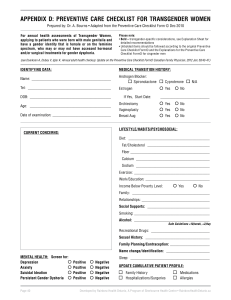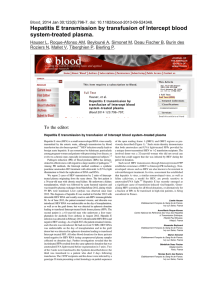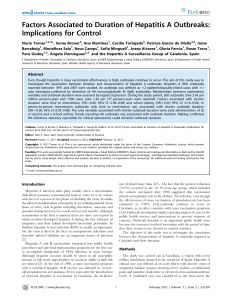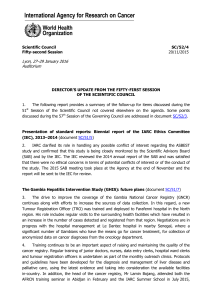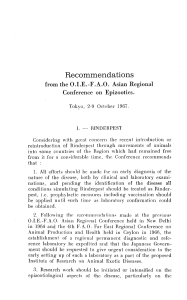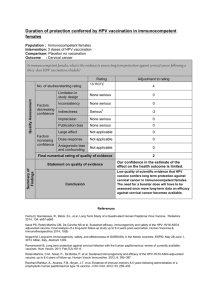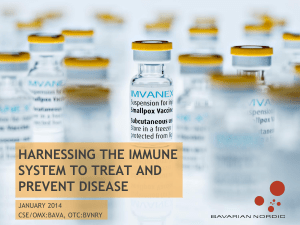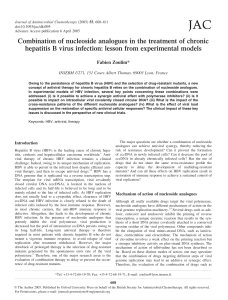000567054-02.pdf (221Kb)
publicité
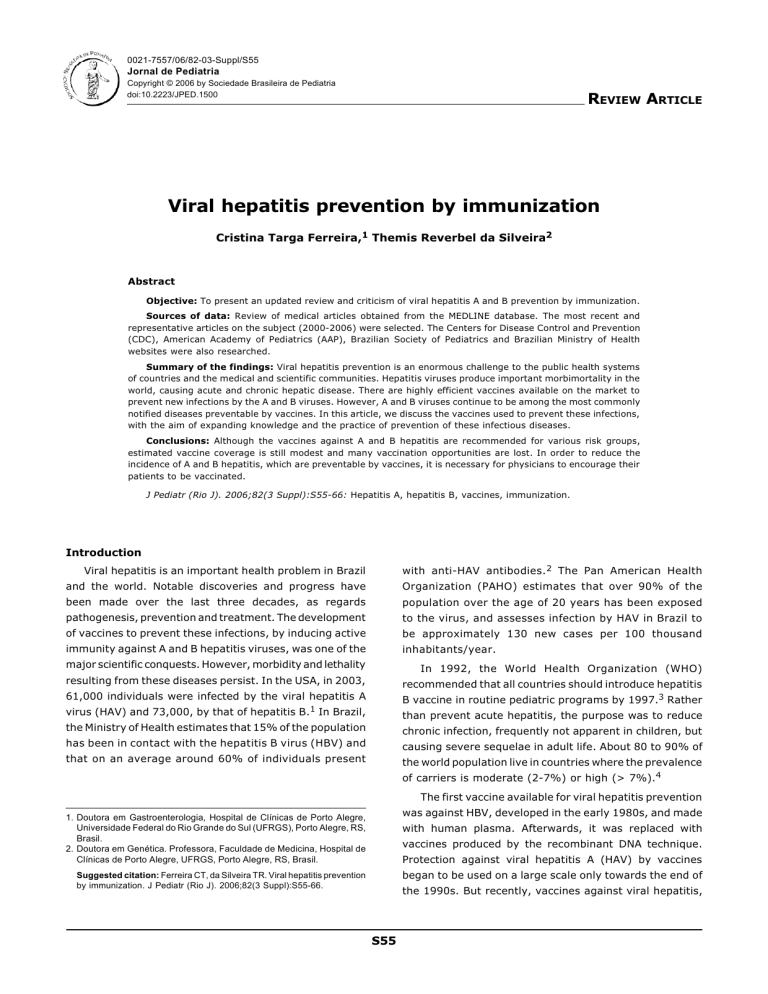
0021-7557/06/82-03-Suppl/S55 Jornal de Pediatria Copyright © 2006 by Sociedade Brasileira de Pediatria doi:10.2223/JPED.1500 REVIEW ARTICLE Viral hepatitis prevention by immunization Cristina Targa Ferreira,1 Themis Reverbel da Silveira2 Abstract Objective: To present an updated review and criticism of viral hepatitis A and B prevention by immunization. Sources of data: Review of medical articles obtained from the MEDLINE database. The most recent and representative articles on the subject (2000-2006) were selected. The Centers for Disease Control and Prevention (CDC), American Academy of Pediatrics (AAP), Brazilian Society of Pediatrics and Brazilian Ministry of Health websites were also researched. Summary of the findings: Viral hepatitis prevention is an enormous challenge to the public health systems of countries and the medical and scientific communities. Hepatitis viruses produce important morbimortality in the world, causing acute and chronic hepatic disease. There are highly efficient vaccines available on the market to prevent new infections by the A and B viruses. However, A and B viruses continue to be among the most commonly notified diseases preventable by vaccines. In this article, we discuss the vaccines used to prevent these infections, with the aim of expanding knowledge and the practice of prevention of these infectious diseases. Conclusions: Although the vaccines against A and B hepatitis are recommended for various risk groups, estimated vaccine coverage is still modest and many vaccination opportunities are lost. In order to reduce the incidence of A and B hepatitis, which are preventable by vaccines, it is necessary for physicians to encourage their patients to be vaccinated. J Pediatr (Rio J). 2006;82(3 Suppl):S55-66: Hepatitis A, hepatitis B, vaccines, immunization. Introduction Viral hepatitis is an important health problem in Brazil with anti-HAV antibodies. 2 The Pan American Health and the world. Notable discoveries and progress have Organization (PAHO) estimates that over 90% of the been made over the last three decades, as regards population over the age of 20 years has been exposed pathogenesis, prevention and treatment. The development to the virus, and assesses infection by HAV in Brazil to of vaccines to prevent these infections, by inducing active be approximately 130 new cases per 100 thousand immunity against A and B hepatitis viruses, was one of the inhabitants/year. major scientific conquests. However, morbidity and lethality In 1992, the World Health Organization (WHO) resulting from these diseases persist. In the USA, in 2003, recommended that all countries should introduce hepatitis 61,000 individuals were infected by the viral hepatitis A B vaccine in routine pediatric programs by 1997.3 Rather virus (HAV) and 73,000, by that of hepatitis B.1 In Brazil, than prevent acute hepatitis, the purpose was to reduce the Ministry of Health estimates that 15% of the population chronic infection, frequently not apparent in children, but has been in contact with the hepatitis B virus (HBV) and causing severe sequelae in adult life. About 80 to 90% of that on an average around 60% of individuals present the world population live in countries where the prevalence of carriers is moderate (2-7%) or high (> 7%).4 The first vaccine available for viral hepatitis prevention was against HBV, developed in the early 1980s, and made 1. Doutora em Gastroenterologia, Hospital de Clínicas de Porto Alegre, Universidade Federal do Rio Grande do Sul (UFRGS), Porto Alegre, RS, Brasil. 2. Doutora em Genética. Professora, Faculdade de Medicina, Hospital de Clínicas de Porto Alegre, UFRGS, Porto Alegre, RS, Brasil. with human plasma. Afterwards, it was replaced with vaccines produced by the recombinant DNA technique. Protection against viral hepatitis A (HAV) by vaccines began to be used on a large scale only towards the end of Suggested citation: Ferreira CT, da Silveira TR. Viral hepatitis prevention by immunization. J Pediatr (Rio J). 2006;82(3 Suppl):S55-66. the 1990s. But recently, vaccines against viral hepatitis, S55 S56 Jornal de Pediatria - Vol. 82, No.3(Suppl), 2006 Viral hepatitis prevention by immunization Ferreira CT & da Silveira TR associated with antigens of HAV and HBV viruses, and against HAV, and the use of sensitive immunoassays and vaccines combined with the antigens of other infectious antibody neutralizing tests made it feasible to recognize agents, have been made available on the market. The the immunogenic capability of the different vaccines. implementation of global immunoprophylaxis programs Fortunately the HAV virus exists all over the world with was efficient and there was significant reduction in infections one single serotype, with a small degree of antigenic by HAV and HBV in various regions.2 At present, hepatitis variation. 9 Present evidence has shown that immunity, A and B immunoprophylaxis is done with safe vaccines, either acquired naturally or by inactivated vaccines, protects available practically all over the world, and the against the different virus A strains.9 The antibodies recommendations of the Health agency officials in different resulting from the vaccine, although lower in number, countries are well documented. have the same neutralizing capacity as the antibodies In Brazil, although the number of notifications does not naturally produced after infection. Although there is genetic reflect the true incidence of the infection, studies on heterogeneity among the different virus A strains, it would seroprevalence for hepatitis A show that the national appear that there is no significant variation in the mean is around 65%.5 Among the cases of viral hepatitis conformation of the epitope that determines virus notified to the health services, approximately half are due neutralization, as polyclonal antibodies neutralize the to HAV. virus of all the genotypes. 9,10 As HAV immunity is mainly In the United States, where home and sexual contact with infected persons was the main HAV transmission mode between 1996 and 2002, there was a reduction in the incidence of the disease, mainly in the group from 5 to 14 years of age. It was observed, however, that the incidence of HAV among persons that travel to endemic areas and men that have sexual relations with men has increased dramatically since 1995.4,6 The number of chronic virus B carriers in the world is estimated at 450 million, and at around 2 million in Brazil. In the USA, although there was a large reduction in the incidence of acute hepatitis B, mainly in the group from 15 to 39 years of age, this continues to be the age group most affected by acute infection.6 Individuals that have multiple sex partners and are drug users continue to be the main transmitters of the disease in that country.6 It is estimated that the risk of developing hepatocarcinoma is 100 times higher among HBV carriers, in comparison with those that do not have the virus, and that 15-20% of those that have The reason for reviewing and expanding current knowledge and the recommendations about these vaccines is based on the high rates of viral hepatitis A and B in some regions of the country, and the persistence of insufficient protection of individuals that become infected and propagate viral epitopic conformation to the individuals immune system in a sufficient dose to induce the formation of neutralizing antibodies. To confer lasting protection, the levels of these antibodies must be considerably higher than those acquired with immunoglobulins. The following safe and highly efficient vaccines, produced with virus inactivated by formalin, have been available on the market for years: Havrix ® (GlaxoSmithKline), Vaqta® (Merck), Avaxim® (Sanofi Pasteur) and Epaxal® (Berna). Their licensure has added an important benefit to the immunoprophylaxis arsenal, and has certainly changed the scenario of hepatitis A prevention.1 In the public health system, the vaccine is available only in the Special Immunobiology Referral Centers (CRIE Centros de Referência de Imunobiológicos Especiais) and is distributed for specific groups of individuals. The different vaccines sold in Brazil, with their presentations and doses, are shown in Table 1.2 Although the vaccine doses and formulations are HBV may die prematurely.3 infecction.1,4,6,7 mediated by antibodies, the vaccine needs to present the The objective of this article is to review hepatitis A and B prevention by vaccination, describe the properties of the vaccines, review clinical studies and their results and, finally, discuss the impact of introducing these vaccines. different, both the number and the dose intervals are the same: they must be administered in 2 doses, with a 6month interval between them. Still limited data indicate that if this interval between the 1st and 2nd dose cannot be observed, the antibody concentrations will not be compromised to a major extent. Generally speaking, considering the excellent results obtained with the vaccine, there is no need for post-vaccinal tests. The HAV vaccine is derived from viruses adapted in cell cultures, afterwards purified and inactivated with formalin and finally adsorbed to an adjuvant, generally aluminum hydroxide. Hepatitis A vaccine Clinical studies, based on millions of doses administered In 1978, Provost & Hillemann,8 in animal studies, to healthy persons, demonstrated the protective efficacy demonstrated the ability of a vaccine inactivated by and tolerability of the inactivated vaccines.11,12 Even formalin to produce protective antibodies against HAV. vaccination schemes with 1 dose only of the vaccine The possibility of cultivating the virus in cell cultures made provide immediate protection.13 The anti-HAV antibody it possible to manufacture large quantities of the vaccine levels after one single dose of the vaccine are greater than Jornal de Pediatria - Vol. 82, No.3(Suppl), 2006 S57 Viral hepatitis prevention by immunization Ferreira CT & da Silveira TR Table 1 - Preparations and recommended doses of vaccines against hepatitis A Type of vaccine Age (years) Dose Volume (mL) Number of doses Scheme (months) Havrix® * 1-18 > 18 720 ELISA 1440 ELISA 0.5 1.0 2 2 0 and 6-12 0 and 6-12 Vaqta® 1-17 > 17 25 U 50 U 0.5 1.0 2 2 0 and 6-12 0 and 6 Avaxim® Epaxal® § Twinrix ® * (Hep A+B) >1 160 U 0.5 2 0 and 6-18 >1 500 U 0.5 2 0 and 6 1-15 360 ELISA + 10 µg of HBsAg (Hep B) 0.5 3 0, 1 and 6 1-5 720 ELISA + 20 µg of HBsAg (Hep B) 1.0 2 0 and 6-12 > 16 720 ELISA + 20 µg of HBsAg (Hep B) 1.0 3 0, 1 and 6 * GlaxoSmithKline; † MerckSharp & Dohme; ‡ Sanofi Pasteur; § Berna Biotech. those produced by immunoglobulin, but are lower than Avaxim). The two vaccines showed similar results; when those generated by natural infection.6,14,15 After 1 month the antibody levels were higher than 20 mUI/mL, they from the first dose > 97% of the children and > 95% the remained for at least 10 years after completing the adults developed protective antibody levels (defined as 10 vaccination scheme. It should be remembered that to 20 UI/L).6,16 In the seventh month, that is, 1 month responsive individuals with decreasing and even after the second dose, virtually 100% of the persons undetectable titres may continue to be protected through presented protective anti-HAV antibody levels. The classical the anamnestic anti-viral response.11,13 In these vaccinated studies of Innis11 and Werzberger,12 involving 38,175 individuals, antibodies were detected on re-exposure to children from 1 to 16 years of age, and 1,037 children from the antigen, thus confirming the immunologic memory.19 2 to 16 years of age, in Thailand and New York, showed Although the duration of vaccine induced protection has that the vaccines provided protection in 94% and 100%, not been well determined, the mathematical models respectively. The authors demonstrated that the side suggest that protective antibody levels may persist for 24 effects of these vaccines were similar or less intense than to 47 years after the second dose, administered 6 to 12 those caused by placebo or those caused by hepatitis B months after the first.20 vaccine. In addition, the frequency of adverse effects, except fever, diminished with successive doses.13,17 Cederna et al. 19 demonstrated cellular proliferation in response to the vaccine in 10 patients. The vaccine Immune response to infection by HAV is complex, but induced an early T cell proliferation response, which clearly involves cellular and humoral immunity, cellular persisted for at least 5 months, and was accompanied by immunity being necessary in order to develop immunologic gama-interferon production. This virus-specific T cell memory. Various studies have shown that anti-HAV vaccine response suggests that vaccinated individuals present induces humoral immunity, with seroconversion levels of with an early immune reaction (anamnestic) when in the up to100%. In accordance with viral kinetic models, presence of the virus, rapidly producing high levels of protection determined by the inactivated vaccine remains neutralizing antibodies. Thus, every time the individual for at least 5 to 10 years, with the possibility of continuing comes into contact with the virus, this may act as a to protect the individuals for up to 20 years after vaccination. booster dose of the vaccine, suggesting that there is an Van Herck et al.18 developed mathematical models to immunologic memory present in individuals that receive assess the development of anti-HAV antibodies, after the inactivated vaccine against HAV. 19 It should be administration of 2 inactivated vaccines (Havrix and remembered that the efficacy of immunoglobulin is S58 Jornal de Pediatria - Vol. 82, No.3(Suppl), 2006 Viral hepatitis prevention by immunization Ferreira CT & da Silveira TR related to the circulating antibodies, and thus only to of hepatitis A patients; day care center workers; health humoral immunity.18,19 professionals; individuals that are susceptible while there are outbreaks of the infection; residents in Over the last few years the incidence of viral hepatitis orphanages and institutions; illegal drug users; workers A in the United States has shown an important decline with in contact with untreated water; children living in areas the use of the vaccine, from 12 cases/100,000 individuals in 1995 to 3.1 cases/100,000 in 2002.4,6,21 of intermediate endemicity. This reduction was higher in the states where vaccination of all children In some groups, as happens with other vaccines, the over the age of 2 years was recommended by the Advisory vaccine against HAV may not result in protective response Committee for Immunization Practices (ACIP). As from in all susceptible vaccinated individuals, mainly in 1999 a decrease of 67% from 7.2 cases/100,000 to 2.4 immunodepressed patients. 21 cases/100,000 in 20024,6 was observed. This reduction hepatitis A vaccine is inactivated, no special precaution was similar in 6 other North American states, where the needs to be taken to vaccinate immunodepressed vaccine was recommended, although not mandatory individuals.21 69% reduction, from 6.4 cases/100,000 to 2 cases/ Considering that the Some studies show that adult individuals infected 100,000 in 2002.4,6 In the other 33 states, where the HAV with HIV present lower seroprotection rates, as well as vaccine HAV was not established as routine, the reductions lower serum levels of anti-HAV antibodies after vaccine in incidence of the disease were much lower 35%, from application.23 A Brazilian study demonstrated that the 3.4 cases/100,000 in 1999 to 2.2 cases/100,000 in 2002. geometric mean of anti-HAV antibody titres did not A great reduction in hepatitis A cases occurred in the age differ among children infected by HIV and those who group from 5 to 14 years between 1996 and 2002.4,6 were negative. 24 Recently there was an important change in the The prevalence of antibodies against HAV was recommendations of the ACIP. Both the guidance to analyzed by Gouvea et al., 25 in 352 children and vaccinate all children from 12 to 23 months old and the adolescents exposed and/or infected by HIV in São recommendation to include the vaccine against hepatitis Paulo, with positivity having been observed in only 26%. A in the routine vaccinal calendar of children and adolescents None of these patients had been vaccinated against were approved.22 hepatitis A. The possibility of infection by HIV being more serious when associated with HAV makes prophylaxis mandatory in this group of patients. Some HAV vaccine in special groups authors suggest that the vaccine should be offered at an early stage of infection by HIV.26,27 Other groups of There are various indications for vaccination against hepatitis virus, 2,7 individuals as follows: Chronic liver diseases; with immunodepressed patients, such as chronic renal, disturbances; dialyzed and hemophilic patients have been studied and immunodepressed persons; homosexuals of both presented variable responses, but with good genders; travelers to endemic zones; family members seroconversion rates 28-31 (Table 2). Table 2 - coagulation Seroconversion rates and GMT of HAV vaccine in special groups Study (application interval) Group of patients Age in years (x) n % seroconversion (cut-off value) Final GMT (mUI/mL) Cañero-Velasco et al.29 (IM, 1-6 m) Chronic renal Nephrotic syndrome 2-9 (5.3) 16 100% (≥ 20 mUI/mL) 361 HIV + HIV - 21-60 (33.2) 26 20 (≥ 76.9% 100% 20 mUI/mL) 636 1,687 Hemophiliacs HIV + HIV - 1-50 (17) 47 66 (≥ 85% 100% 20 mUI/mL) 503 3,199 Down syndrome 1-11 (3.96) 49 Hess et al.23 (IM, 0, 1-6 m) Santagostinho et al.26 (SC, 1-6 days) Ferreira et al.35 (IM, 0 and 6 m) IM = intramuscular; SC = subcutaneous. 100% (> 33 mUI/mL) 1,719.86 Jornal de Pediatria - Vol. 82, No.3(Suppl), 2006 S59 Viral hepatitis prevention by immunization Ferreira CT & da Silveira TR The Pediatric Council of the American Liver Foundation32 American regions, a decrease in cases in younger age recommends the vaccine for children with any type of groups has been noted over the last few years, with a shift chronic hepatic disease. The authors consider that HAV in the seroprevalence curve of the infection to the adult may with age group.41 This basically occurs as a result of the immunodeficiencies and alert to the fact that HAV may improvement in the populations sanitary and socio- serve as a trigger for self-immune hepatic diseases in economic conditions. be particularly serious in children predisposed individuals.28,31,32 Although persons with The existence of vaccine against HAV makes it feasible chronic hepatic disease do not present increased risk of to substantially reduce the incidence of the disease, contracting HAV, they do appear to have a greater eliminate virus transmission and, eventually, even to propensity for developing complications and for evolving eradicate the infection. Reduction in the incidence of the towards death when they contract the infection.14,21,23,31 disease will be attained through promoting high levels of The response of patients with decompensated chronic immunity in persons who serve as reservoirs of the virus. hepatic disease is known to be lower, with lower antibody This highly immunized population will diminish the incidence levels and lower seroconversion rates, when compared to of HAV and, presumably, virus circulation. those with compensated disease.6,17,33,34 The possibility of implementing anti-HAV vaccine in the Response to the vaccine was recently assessed in Porto public systems calendar demands special considerations. Alegre, in children with Down syndrome and chronic Among others, the following aspects must be taken into hepatopathies.35-37 Satisfactory seroconversion results account: The local epidemiologic characteristics, cost of were obtained, but with lower antibody titres than those the vaccine, the populations health conditions and the in normal children in the same age group. The results are vaccinal cover of other infections. For example, a recent given in Tables 2 and 3. seroepidemiologic study of Indian schoolchildren between The seroconversion rates 1 month after the two doses the ages of 4 18 years, showed that at 5 years of age of the vaccine against HAV (0- and 6- month scheme) are 80% already presented with positive anti-HAV antibodies, similar among healthy adults and individuals with chronic thus showing that mass vaccination in this population hepatitis B (98.2 vs. 97.7%), with chronic hepatitis C (even at the age of 5 years) would probably not be cost effective. 42 (98.2 vs. 94.3%) or with other hepatopathies ( 98.2 vs. 95.2%).6,17,30 It is not easy to define the epidemiologic characteristics Nebbia et al.38 studied children and adolescents of up of viral hepatitis in countries of continental dimensions, to 16 years of age with cirrhosis and observed an adequate such as Brazil. On the other hand, the high percentage of response to HAV vaccine. The results are given in Table 3. asymptomatic cases of viral hepatitis A determines that seroprevalence is a better epidemiologic indicator than incidence of the infection. Thus, Costa-Clemens et al. 5 Impact of anti-HAV vaccination studied the seroprevalence of HAV in four Brazilian capitals The epidemiologic status of a certain region is not and showed a heterogeneous pattern among the different static, it presents changes due to various factors. Among regions. They concluded that children, adolescents and them, perhaps the most important is change in socio- young adults in our country, seronegative for anti-HAV, economic and hygiene conditions.39,40 In some Latin have a similar risk to that of travelers to highly endemic Table 3 - Seroconversion rates and GMT of HAV vaccine in children and adolescents who are chronic hepatitis carriers Study Group of patients Age in years (x) n Vaccine (months) % seroconversion (1 m-7 m) Final GMT (mUI/mL) Nebbia et al.38 HBsAg carriers 24 chronic hep. 0 cirrhosis 2-15 (10.7) 33 Havrix 360 UE (0, 1 and 6) 90,9% 100% 3,776.8 Ferreira et al.36 Cirrhosis AVBEH Autoimmune Others 1-14 (4.3) 10-16 (12.4) 2-15 (8.4) 17 7 10 Havrix 720 UE (0 and 6) 94-100% 57-100% 60-90% 1,490.55 506.18 395.44 S60 Jornal de Pediatria - Vol. 82, No.3(Suppl), 2006 Viral hepatitis prevention by immunization Ferreira CT & da Silveira TR regions, considering that they are not protected and are program had been designed to protect the high risk under continual risk of exposure. population, there was a rapid and important decline in the In Porto Alegre, this heterogeneous pattern was also shown, in accordance with social class, evidencing the notification rates and the benefit was soon extended to other groups in the community.49 need for anti-HAV vaccination. Susceptible children (with Children at pre-school age must be the main focus of negative anti-HAV antibody) live in the same areas where immunization strategies, because of their critical role in HAV is common43 (Figure 1). In a similar study conducted virus transmission.21,45-47,50 As has been demonstrated in São Luís do Maranhão, the prevalence of IgG anti-HAV by different studies, the efficient way to diminish incidence in 462 children from state and private schools, with ages of the disease and even eradicate the infection is mass ranging between 7 and 14 years, was 71.5% and 36.5% vaccination of children. There are, however, many barriers respectively.44 to this measure being adopted, among them: the growing number of vaccinations in childhood, other public health priorities, the cost of vaccine and the reduced number of cost-effectiveness studies of this strategy for our country. Until this happens, the strategy applied in our country will Anti-HIV A+ 80 continue to be that of preventing HAV in risk groups, 70 respecting hierarchy as regards the destination of available 60 public resources. While mass vaccination does not occur, 50 we will continue to see patients develop severe hepatitis 40 conditions, including the fulminant form. Recently, in a 30 multi-centric study, we demonstrated that approximately 40% of hepatic insufficiency cases in children in Latin 20 America are due to hepatitis A.51 10 0 1-4 5-9 10-14 15-19 Hepatitis B vaccine Age groups Low socio-economic level Up to the present time, hepatitis caused by the virus High socio-economic level B is one of the main causes of hepatic disease in the world. Figure 1 - Prevalence of anti-HAV antibody in two socio-economic levels in Porto Alegre Epidemiologic studies revealed a strong relation between infection by HBV, cirrhosis and hepatocellular carcinoma and it is calculated that around 1 million people die because of hepatic disease complications every year.1,4,6,7,51,52 The chronic hepatitis caused by HBV has been revealed as a complex, difficult to manage disease Up to now no large scale anti-HAV vaccination strategies because of, among other factors, peculiarities in the virus- have been established in Latin American countries. One host relationship, the appearance of mutants, viral the one hand, in the highly endemic regions, it is almost heterogeneity and the diversity of clinical forms.53 In the impracticable to identify the groups at risk for acquiring USA it was estimated that in the course of his/her lifetime, the disease; and on the other, the high cost of vaccine an individual has a 5% chance of coming into contact with makes it difficult to extend this benefit to the entire HBV.4,21 population.45-47 The main purposes of vaccination against HBV are to Israel was the first country to adopt universal vaccination prevent acute disease, prevent hepatopathy from becoming for children at 18 and 24 months of age in June 1999, and chronic the results were excellent.48 A very recent analysis of the hepatocarcinoma and, furthermore, to contribute to impact of this program, 5.5 years after it began, reveals minimizing viral transmission. The characteristics of HBV that an important decline has been observed in the transmission make it necessary to implement complex incidence of the disease in all age groups, with 90% vaccination strategies, in order to protect newborns, coverage for the first dose and 85% for the second.48 and developing into cirrhosis and/or The adolescent and adults. The strategy used by the WHO, authors suggest that universal immunization programs endorsed by practically all the other official organizations designed for pre-school children are highly effective and for controlling infection by virus B, was to introduce feasible.48 vaccine for all children at birth.4,54,55 Another recent study conducted in Australia also In the low risk populations, such as the majority of revealed the impact of vaccination in indigenous children states in Brazil, where transmission primarily occurs in (two doses applied at 18 and 24 months).49 Although the older individuals, immunization of newborns is used to Jornal de Pediatria - Vol. 82, No.3(Suppl), 2006 S61 Viral hepatitis prevention by immunization Ferreira CT & da Silveira TR prevent contamination at the beginning of life and the booster doses are not habitually recommended, unless in disease from becoming chronic. It is known that the risk some special risk groups. 6,55 of developing chronic infection is inversely related to age6,7 (Table 4). By vaccinating children at the beginning of life, horizontal contamination, so frequent in homes where there is an HBV carrier, is also reduced. In addition, when the vaccinal scheme is instituted at this stage of life, there is greater probability of complete series of vaccination being carried out.52 Within the scope of public health, routine assessment of serologic infection markers is not recommended in candidates for vaccination (children and adults), and postvaccinal anti-HBs research in the serum of immunocompetent individuals is not required. The vaccines sold in Brazil, with presentations and doses, are shown in Tables 1 and 5.2 Generally they are administered in 3 doses, the second and third doses being applied 1 and 6 months, respectively, after the first. If the series is interrupted after the first dose, the second must Table 4 - Age at infection in relation to possibility of becoming a chronic hepatitis B virus carrier Childs age (years) Percentage (%) of children that become chronic carriers <1 70-90 2-3 40-70 4-6 10-40 >7 6-10 be given as soon as possible and the third at least 2 months after the second. If only the third dose is lacking, it must be administered immediately. Alternative schemes may be used in the following manner:22 Fast vaccination: 1st dose on day 0 and the other doses after 1, 2, and the booster at 12 months; Accelerated vaccination: 1st dose on day 0 and the other doses after 7 and 21 days, and the booster at 12 months; 2-dose scheme: 1st dose on day 0 and the other 6 12 months later (special individuals). The prognosis of chronic hepatitis acquired in childhood remains uncertain. Reactivation of viral replication, or of hepatic disease, may occur much later, at an adult age, and the seroconversion for anti-HBe is not always associated with the disappearance of HBV-DNA and/or with remission of the hepatopathy. Safe and efficient vaccines against HVB are available all over the world. In global terms, it is estimated that over Table 5 - Preparations and recommended doses of vaccines against hepatitis B Vaccine 1 billion people have already received vaccine against Engerix-B® * Hepatitis B; in the USA, calculations point towards over 40 Euvax® million children and 30 million adults already vaccinated.6,55 The antigen used in the currently available vaccines is a recombinant HBsAg produced by inserting a plasmodium containing the surface antigen gene into the cells of a fungus.6,55 After purification, HBsAg is adsorved to Recombivax-HB® Age or group Dose (µg) Volume (mL) Scheme 0-19 10 0,5 0, 1, 6 > 20 Dialysis 20 40 1.0 2.0 0, 1, 6 0, 1, 2, 6 0-19 > 20 5 10 0.5 1.0 0, 1, 6 0, 1, 6 * GlaxoSmithKline; † Sanofi-Pasteur; ‡ Merck Sharp and Dohme. aluminum hydroxide, and the end product contains over 95% of HBsAg protein, less than 5% of proteins derived from the fungus and no fungus DNA detectable in the Post-vaccination tests are advisable for certain vaccines are formulated individuals: Children born to infected mothers (must be without preservatives and the Engerix-B® vaccines are assessed between 9 and 15 months), health professionals considered free of preservatives, although they may in contact with blood and/or derivatives, hemodialyzed contain traces of mercury after the removal of timerosal. patients (test 1 to 2 months after the last dose of the These vaccines undergo post-production timerosal removal, vaccine) and sexual partners of HBV carriers (test 1 to 2 which is considered to have no biologic effect.6 Protection months after the last dose of the vaccine). vaccine. The Recombivax-HB® by the vaccine against hepatitis B is, at least partially, In Brazil, the Programa Nacional de Imunização derived from the immunologic memory established. The (Brazilian National Immunization Program) recommends antibody levels derived from the vaccine normally decline that the first dose of the vaccine be administered in the with time, but they remain for at least 15 years after the maternity hospital within the first 12 hours of life. If complete series of vaccination, and are reactivated when adolescents (11 to 19 years old) have no proof of previous necessary, by the immunologic memory. For this reason, vaccination, the series must be started.2 S62 Jornal de Pediatria - Vol. 82, No.3(Suppl), 2006 Viral hepatitis prevention by immunization Ferreira CT & da Silveira TR Protection by the vaccine against HVB increases with effects of the recombinant vaccine were significant 12 the number of doses applied. Generally speaking, this is year later. The authors believe that the vaccine booster is a very efficient vaccine with protection rates of 95%, with not necessary in these children, since the HBsAg positivity variations of 80 to 100% among those individuals that are rate in this population did not rise in later years.58 submitted to the complete vaccination scheme. Protection Zanetti et al.,59 in Italy, analyzed immunity duration is considered to exist when the antibody titres to HBsAg and the eventual need for a booster dose in 1,212 children (anti-HBs) are higher than 10 mUI/mL.6 In the pediatric and 446 air force recruits, after 10 years of implementing age group, the protection levels attained with the vaccine vaccination in nursing infants and adolescents in that are 16% to 40% after a single dose, 80% to 95% after two country. They concluded that a strong immunologic memory doses and 98 to 100%, after three doses.6,54 In premature persists for over 10 years after a primary course of newborns, weighing less than 2 kg, the antibody levels are immunization, and booster doses of the vaccine are lower and the seroconversion rates smaller. A recent unnecessary. study conducted by Sadeck & Ramos,56 about response to vaccination in pre-term newborns, showed a similar response to that in full term babies. However, in 25% of those with birthweight equal to or lower than 1,500 g, the response was not satisfactory. The authors indicated the need to assess seroprotection after the third dose of the vaccine or administer 1 booster dose at 12 months.56 Among adolescents and adults, the antibody response rates are 20% to 30% after one dose, 75% to 80% following two doses and 90% to 95% after three doses.6 The assurance of the vaccines long-term efficiency is due to the anamnestic anti-HBs response.4,6,7 There is no doubt that immunoprophylaxis has the greatest cost-benefit for global control of infection by the virus B and its complications.60 Passive immunization by hyper immune immunoglobulin (HBIG), provides temporary immunity at a high cost. Therefore, the most efficient strategy has been universal immunization programs to prevent both perinatal and horizontal transmission of infection by the hepatitis B virus. The strategies indicated for universal immunization and the risk groups are presented as follows, as well as in Table 67,60: children of HBsAg-positive mothers; home contacts of individuals infected by HBV; workers exposed The factors that diminish hepatitis B vaccine to blood and/or hemoderivatives; patients having frequent immunogenicity, in addition to inadequate care of the blood and/or hemoderivative transfusions; persons that material (cold chain, for example) include: Age over 40 frequent hemodialysis units; prisoners in correctional years, male sex, smoking, obesity and immunologic institutions; promiscuous men that have sex with men; deficiency.4,6,7 persons that have more than one sexual partner in a Duval et al.,57 in a 15-year prospective study, compared period of 6 months; injectable drug users; the immunogenicity of two pediatric vaccines (Engerix-B® immunodepressed patients; lifesavers/firemen; persons and Recombivax-B®) and the effect of the booster dose originating from high endemicity zones; contacts of given 5 years afterwards in a county with low endemicity immigrants originating from endemic zones. Canada. They observed that immunity persisted for 5 The strategies depend both on local epidemiologic years after the primary vaccination in 99% of the vaccinated conditions (high or low prevalence of HBsAg in children) children from 8 to 10 years of age. There would appear to and governmental resources for implementing vaccination. be long protection (10 to 12 years) in children at greater In areas where prevalence of infection by HBV is low, or risk, vaccinated at birth (HBsAg positive and HBeAg financial resources are limited, immunization with 3 doses positive mothers). of the vaccine, without pre-natal triage and without the Immunity duration in low risk children born to HBsAg concurrent administration of HBIG, is a reasonable strategy, negative mothers, vaccinated soon after birth, is still saves resources and has shown to be efficient in countries under discussion. 51 In these individuals, the risk could reappear during adolescence and the beginning of sexual life. such as Thailand and in other Asian countires.60-62 Over the last few years some innovations related to vaccines have been assessed. New application routes Petersen et al.52 studied post-vaccination protection (intranasal, transcutaneous, aerosol and oral), new devices duration in high and low risk children of 4 to 13 years of (microneedle system), purpose of use (prophylactic or age, vaccinated at birth. They observed that in the therapeutic) and time of vaccine administration are being majority of cases, anti-HBs disappears at around 5 years tested.63 Thus, Patwardahan et al.64 recently tested pre- of age, although a large number of them showed natal vaccination in mothers belonging to high risk immunologic memory. In a third of these children, there populations and the results were encouraging when the was failure in the anamnestic response after a booster mothers were vaccinated in the 20th and 24th weeks of dose. On the other hand, Gong et al.,58 in China, assessed gestation. vaccination protection 3 to 12 years after vaccination at In a recently published study, various international birth in 2,419 children, and concluded that the protective agencies, including the WHO and the CDC, affirmed that Jornal de Pediatria - Vol. 82, No.3(Suppl), 2006 S63 Viral hepatitis prevention by immunization Ferreira CT & da Silveira TR Table 6 - Strategies indicated for universal immunization against HVB in accordance with the different endemicity patterns Regional prevalence Maternal Screening HbsAg/HBeAg HBV immunization HBIG/HBV vaccine Cost High Yes/yes Yes*/yes High Low with high risk groups Yes/no Yes/yes High High No/no No/yes Low Low No/no No/yes Low * Children of high risk mothers (HBeAg positive). up to now there are no data to conclude that the vaccines, of the immune system could lead to a reduction in the particularly hepatitis B, present health risks, and that capacity to respond to the vaccine.67 there are no justifications for changing current immunization With regard to chronic hepatopathies, when they practices.65 However, the scars left by irresponsible present light or moderate disease, vaccination results are reports that link severe adverse effects to vaccines may similar to those of healthy adults, attaining up to 100% have an important impact on immunization coverage. seroconversion in some studies.6,17,33 In patients with cirrhosis due to alcohol, seroconversion rates are low, ranging from 12% to 75% and in patients on liver HVB vaccine in special groups transplant lists they are even lower, ranging between 7% It is generally known that the immunogenic capacity of and 55%.6 vaccine is lower in certain groups of persons, among Vaccine against HBV is recommended at higher doses them: The elderly, obese, alcoholics, individuals submitted in patients on hemodialysis. Seroprotection has been to antiblastic chemotherapy and immunodepressed documented in 64% of patients with a normal vaccination patients. To improve response to vaccine, some strategies scheme of three doses, and 86% in those that received an could be implemented. Kappor et al.,66 for example, used extra dose of vaccine.4,6 The response basically depends the granulocyte formation stimulating factor with on the doses used and the stage of the renal disease at encouraging results. which the patient was vaccinated. Those that present Premature newborns, weighing less than 2 kg at birth, should receive the first dose of the vaccine when the child is 1 month old.22 Response to the vaccine, under this circumstance, is comparable to that of full term children, irrespective of the birthweight and gestational age.22 Hepatitis B vaccine immunogenicity is low in patients infected with HIV, but the ideal vaccination scheme for these patients is still undefined. There is limited information creatinine over 4 mg/dL, and are on dialysis, respond in a worse manner than those with more moderate renal insufficiency. Chronic nephropathies must be vaccinated as early as possible and it is advisable to institute vaccination before submitting them to dialysis. In these patients, annual antibody level (anti-HBs) monitoring is indicated, as well as a booster dose when these levels are below 10 mUI/mL.4,6 about the duration of immunologic memory and the most suitable time to start vaccination in severely Impact of anti-HVB vaccination immunodepressed patients. It is known that the serologic Immunization against hepatitis B has always been a response is directly proportional to the CD4 level. Studies successful experience in universal vaccination campaigns conducted during the 1980s and 1990s, analyzing adults in the different countries. It is well known that success is infected by HIV, demonstrated responses between 33% not achieved when the strategy is oriented to vaccinating and 56% to recombinant vaccines. North American only risk groups. It is estimated that 25% to 30% of adolescents infected by HIV, vaccinated against hepatitis persons with hepatitis B deny having any risk factor B, showed a diminished serologic response, associated whatever for acquiring the infection and therefore, are not with an increase in T cells (CD8+/CD38+). The authors identified as vaccination targets. Men that have sex with suggested that viral replication continued and activation men, intravenous drug users and promiscuous S64 Jornal de Pediatria - Vol. 82, No.3(Suppl), 2006 Viral hepatitis prevention by immunization Ferreira CT & da Silveira TR heterosexuals are important risk groups that are not 100,000 in 1981 to 2.8 cases/100,000 in 2002, the latter usually reached in vaccinal campaigns. In the United rate having been stable since 1999.4,6 States, only after vaccination was recommended for all In countries where the incidence of hepatitis B is low, newborns in 1991, and in 1996, routine immunization of universal vaccination may be considered an unsuitable adolescents from 11 to 12 years of age, was a substantial measure from the public health point of view; in these reduction found in the incidence of hepatitis B.6 Another fundamental measure for reducing the cases, selective immunization would protect the great majority of individuals at risk. incidence of acute virus B hepatitis was the recommendation In Formosa, the mortality rate from fulminant hepatitis to test all pregnant women for HBsAg and to protect the B in nursing infants, between the years 1974 and 1984, newborns of all infected mothers with vaccine and before the universal vaccination era, was 5.36/100,000. immunoglobulin.4,6,21 This rate fell to 1.71/100,000 between 1985 and 1998, The Ministry of Healths National Hepatitis Program is undertaking a series of strategic measures to broaden knowledge related to hepatitis in Brazil.2 One of the aspects that is receiving special attention is serologic screening of HBsAg in pregnant women. The importance of hepatitis B during gestation is mainly because of the high potential of transmission from mother to newborn and the tendency of hepatitis B to become chronic (7090%) when contact occurs at an early age. An enquiry recently carried out to assess gynecologists and obstetricians knowledge with regard to various aspects of hepatitis B revealed an alarming situation.68 Approximately half of the 262 professionals interviewed asked for the marker (HBsAg) for mothers in the first trimester of gestation, although it is known that in order to protect the newborn adequately, screening must be done in the third trimester. On the other hand, the large majority of the professionals (group at risk for hepatitis B) had been vaccinated, but only 58% had performed antiHBs.68 The scheme proposed by the Ministry of Health is represented in Figure 2. In the United States, the cumulative effect of the use of the hepatitis B vaccine has shown important reductions in the incidence of acute hepatitis B from 9.2 cases/ after the vaccination program was launched.67 At present, fulminant hepatitis occurs almost exclusively in infected nursing infants of mothers that are carriers of HBsAg and HBeAg negative. 69-72 Universal vaccination against hepatitis B in these high endemicity countries effectively reduced both perinatal and horizontal transmission, thus diminishing the rates of chronic hepatitis B.60,69-71 In Formosa, the incidence of chronic HBsAg carriers diminished from 10% to 1% in children under the age of 15 years.69 These reductions clearly show that universal vaccination programs are more efficient than vaccination in risk groups. At present, the development of mutants as a result of vaccination programs is of concern in these high endemicity countries. The prevalence of surface antigen gene mutants, which may cause the vaccine to fail, is the current worry, as it increased gradually 5 to 10 years after the programs were instituted. Reduction in HVB infection rates after the universal vaccination programs started had a dramatic effect on the incidence of hepatocellular carcinoma in children in Formosa. The annual incidence of liver cancer diminished by 75%, from 0.52/100,000 in children born before July 1984 to 0.13/100,000 in those born after 1984.72 If these rates continue to decline, there should also be a substantial decrease in hepatocellular carcinoma in adults in the near future. Lastly, it is important to remember that in our country, hepatitis from the Delta virus is still highly prevalent in HBV and gestational screening Serologic screening: HBsAg (3rd trimester) some areas of Eastern Amazonia. As this concerns a defective virus, the distribution of the infection is superimposed on that of hepatitis B. When protecting individuals against HBV, we are also preventing the specter of serious diseases, both of super-infection and co-infection, determined by the association of B and Delta viruses. Negative Vaccinate the pregnant woman if she is ≤ 19 years Vaccinate newborn Positive HBIG and 1st dose of vaccine for newborn Complete investigation of mother Confirm newborn's post-vaccinal immunity with anti-HBs up to 1 year Brazilian Ministry of Health. Figure 2 - Hepatitis B triage in pregnant women Final considerations Infections caused by viral hepatitis A and B generate enormous problems related to morbidity and mortality, in addition to costs, not only with the diseases, but also by determining an increase in the number of liver transplants. Instead of us continuing to think of hepatitis A and B as Viral hepatitis prevention by immunization Ferreira CT & da Silveira TR common diseases that affect our patients, we should perhaps face them now, as infections that can be eradicated from our country. HVB vaccination is already available to all children when they are born, for adolescents up to the age of 19, and for all risk patients in the public health service. HAV vaccine, not yet available in the public health system, should be indicated for patients with financial resources, as these persons form the largest susceptible group and are therefore at greater risk. It should be remembered that for risk groups, this vaccine is available in the public health system at the CRIE in Brazil. Health professionals, the lay community, above all the parents and the media must be continually informed about the benefits and adequate use of the vaccines available in our country. The actions undertaken by the Evandro Chagas Institute team in Amazonia, since 1953, with regard to viral hepatitis, should serve as inspiration to all of us, as in spite of the great deal that has been done, it is necessary to reflect on the wise words of Bensabath and Soares73 the task has not yet been finished. Conflict of interest Cristina Targa Ferreira declares that she has participated in studies on vaccines for Glaxo and Merck Laboratories and currently takes part in a study on hepatitis C (pegIFN/ribavirin treatment) for Roche. Cristina Targa Ferreira and Themis Reverbel da Silveira declare that they have participated as investigators in studies on viral hepatitis for Roche and GlaxoSmithKline Laboratories. References 1. 2. Schiff ER. Introduction. Am J Med. 2005;118 Suppl 10A:1S-6S. Brasil, Secretaria de Políticas de Saúde. Hepatites virais o Brasil está atento. Normas e manuais técnicos. Brasília: Ministério da Saúde; 2003. 3. Expanded programme on immunization. Global advisory group Part 1. Wkly Epidemiol Rec. 1992;67:11-5. 4. Center for Disease Control and Prevention (CDC). Hepatitis surveillance report no. 59. Atlanta: US Department of Health and Human Services, Centers for Disease Control and Prevention; 2004. http://www.cdc.gov/ncidod/diseases/hepatitis/resource/ . Access: 08/02/2006. 5. Clemens SAC, da Fonseca JC, Azevedo T, Cavalcanti A, Silveira TR, Castilho MC, et al. Soroprevalência para hepatite A e hepatite B em 4 centros no Brasil. Rev Soc Bras Med Trop. 2000;33:1-10. 6. Davis JP. Experience with hepatitis A and B vaccines. Am J Med. 2005:118 Suppl 10A:7S-15S. 7. Poland GA. Evaluating existing recommendations for hepatitis A and B vaccination. Am J Med. 2005;118 Suppl 10A:16S-20S. 8. Provost PJ, Hilleman MR. Propagation of human hepatitis A virus in cell culture in vitro. Proc Soc Exp Biol Med. 1979;160:213-21. 9. Andre FE. Approaches to a vaccine against hepatitis A: development and manufacture of an inactivated vaccine. J Infect Dis. 1995;171 Suppl 1:S33-9. 10. Andre FE, DHondt E, Delem A, Safary A. Clinical assessment of the safety and efficacy of an inactivated hepatitis A vaccine: rationale and summary of findings. Vaccine. 1992;10 Suppl 1:S160-8. Jornal de Pediatria - Vol. 82, No.3(Suppl), 2006 S65 11. Innis BL, Snitbhan R, Kunasol P, Laorakpongse T, Poopatanakool W, Kozik CA, et al. Protection against hepatitis A by an inactivated vaccine. JAMA. 1994;271:1328-34. 12. Werzberger A, Mensch B, Kuter B, Brown L, Lewis J, Sitrin R, et al. A controlled trial of a formalin-inactivated hepatitis A vaccine in healthy children. N Engl J Med. 1992;327:453-7. 13. Ginsberg GM, Slater PE, Shouval D. Cost-benefit analysis of a nationwide infant immunization programme against hepatitis A in an area of intermediate endemicity. J Hepatol. 2001;34:92-9. 14. Van Damme P, Thoelen S, Cramm M, De Groote K, Safary A, Meheus A. Inactivated hepatitis A vaccine: reactogenicity, immunogenicity, and long-term antibody persistence. J Med Virol. 1994;44:446-51. 15. Fujiyama S, Odoh K, Kuramoto I, Mizuno K, Tsurusaki R, Sato T. Current seroepidemiological status of hepatitis A with comparison of antibodies titers after infection and vaccination. J Hepatol. 1994;21:641-5. 16. Clemens R, Safary A, Hepburn A, Roche C, Stanbury WJ, Andre FE. Clinical experience with an inactivated hepatitis A vaccine. J Infect Dis. 1995;171 Suppl 1:S44-9. 17. Keeffe EB, Iwarson S, McMahon BJ, Lindsay KL, Koff RS, Manns M, et al. Safety and immunogenicity of hepatitis A vaccine in patients with chronic liver disease. Hepatology. 1998;27:881-6. 18. Van Herck K, Beutels P, Van Damme P, Beutels M, Van den Dries J, Briantais P, et al. Mathematical models for assessment of long-term persistence of antibodies after vaccination with two inactivated hepatitis A vaccine. J Med Virol. 2000;60:1-7. 19. Cederna JB, Klinzman D, Stapleton JT. Hepatitis A virus-specific humoral and cellular immune responses following immunization with a formalin-inactivated hepatitis A vaccine. Vaccine. 1999;18:892-8. 20. Wiedermann G, Kundi M, Ambrosch F, Safary A, DHont E, Delem A. Inactivated hepatitis A vaccine: long-term antibody persistence. Vaccine. 1997;15:612-5. 21. Prevention of hepatitis A through active and passive immunization: recommendations of the Advisory Committee on Immunization Practices (ACIP). MMWR Recomm Rep. 1999;48(RR-12):1-37. 22. Mast EE, Margolis HS, Fiore AE, Brinck EW, Goldstein W, Wang SA, et al. A comprehensive immunization strategy eliminate transmission of hepatitis B virus infection in the United States. Recommendations of the Advisory Committee on Immunization Practices (ACIP) Part 1: Immunization of infants, children, and adolescents. MMWR Recomm Rep. 2005;54:1-31. 23. Hess G, Clemens R, Bienzle U, Schonfeld C, Schunk B, Bock HL. Immunogenicity and safety of an inactivated hepatitis A vaccine in anti-HIV positive and negative homosexual men. J Med Virol. 1995;46:40-2. 24. Gouvea AF, De Moraes-Pinto MI, Ono E, Dinnelli MI, Machado DM, Weckx LY, et al. Immunogenicity and tolerability of hepatitis A vaccine in HIV-infected children. Clin Infect Dis. 2005;41:544-8. 25. Gouvea AF, De Moraes-Pinto MI, Machado DM, Carmo FB, Beltrao SC, Cunegundes KS, et al. Prevalência de anticorpos contra o vírus da hepatite A em crianças e adolescentes expostos e/ou infectados pelo HIV. J Pediatr (Rio J). 2005;81: 205-8. 26. Santagostino E, Gringeri A, Rocino A, Zanetti A, de Biasi R, Mannucci PM. Patterns of immunogenicity of an inactivated hepatitis A vaccine in anti-HIV positive and negative hemophilia patients. Thromb Haemost. 1994;72:508-10. 27. Kemper CA, Haubrich R, Frank I, Dubin G, Buscarino C, McCutchan JA, et al. Safety and immunogenicity of hepatitis A in human immunodeficiency virus-infected patients: a double blind r a n d o m i z e d , p l a c e b o - c o n t r o l l e d t r i a l . J I n f e c t D is . 2003;187:1327-31. 28. Arslan M, Wiesner RH, Poterucha JJ, Zein NN. Safety and efficacy of hepatitis A vaccination in liver transplantation recipients. Transplantation. 2001;72:272-6. 29. Canero-Velasco MC, Mutti JE, Nucifora S, Alvarez K, Antonuccio MC, Sosa A, et al. Safety and immunogenicity after hepatitis A vaccination in pediatric chronic renal disease patients. J Pediatr Gastroenterol Nutr. 2000;31(Suppl 2):S54. 30. Stark K, Gunther M, Neuhaus R, Reinke P, Schroder K, Linnig S, et al. Immunogenicity and safety of hepatitis A vaccine in liver and renal transplant recipients. J Infect Dis. 1999;180:2014-7. 31. Bell BP. Hepatitis A and hepatitis B vaccination of patients with chronic liver disease. Acta Gastroenterol Belg. 2000;63:359-63. S66 Jornal de Pediatria - Vol. 82, No.3(Suppl), 2006 32. Schwarz KB, Balistreri W. Viral hepatitis. In: American Liver Foundation. Pediatric Liver Research Agenda 2000: a blueprint for the future research goals and strategies to treat prevent and conquer childhood liver diseases. New York: American Liver Foundation; 2000. p. 56-63. 33. Keeffe EB. Acute hepatitis A and B in patients with chronic liver disease: prevention through vaccination. Am J Med 2005:118 Suppl 10A:21S-27S. 34. Arguedas MR, Johnson A, Eloubeidi MA, Fallon MB. Immunogenicity of hepatitis A vaccination in decompensated cirrhotic patients. Hepatology. 2001;34:28-31. 35. Ferreira CT, Leite JC, Taniguchi A, Vieira SM, Pereira-Lima J, Silveira TR. Immunogenicity and safety of hepatitis A vaccine in Down syndrome children. J Pediatr Gastroenterol Nutr. 2004;39:337-40. 36. Ferreira CT, da Silveira TR, Vieira SM, Taniguchi AN, PereiraLima J. Immunogenicity and safety of hepatitis A vaccine in children with chronic liver disease. J Pediatr Gastroenterol Nutr. 2003;37:258-61. 37. Ferreira CT, Taniguchi AN, Vieira SM, Pereira-Lima J, da Silveira TR. Prevalência do anticorpo da hepatite A em hepatopatia crônica. J Pediatr (Rio J). 2002;78:503-8. 38. Nebbia G, Giacchino R, Soncini R, Ramaccioni V, Timitilli A, Zanetti AR. Hepatitis A vaccination in chronic carriers of hepatitis B virus. J Pediatr. 1999;134:784-5. 39. McMahon BJ, Beller M, Williams J, Schloss M, Tanttila H, Bulkow L. A program to control an outbreak of hepatitis A in Alaska by using an inactivated hepatitis A vaccine. Arch Pediatr Adolesc Med. 1996;150:733-9. 40. Zamir C, Rishpon S, Zamir D, Leventhal A, Rimon N, Ben-Porath E. Control of a community-wide outbreak of hepatitis A by mass vaccination with inactivated hepatitis A vaccine. Eur J Clin Microbiol Infect Dis. 2001;20:185-7. 41. Tapia-Conyer R, Santos JI, Cavalcanti AM, Urdaneta E, Rivera L, Manterola A, et al. Hepatitis A in Latin America: a changing epidemiologic pattern. Am J Trop Med Hyg. 1999;61:825-9. 42. Acharya SK, Batra Y, Bhatkal B, Ojha B, Kaur K, Hazari S, et al. Seroepidemiology of hepatitis A virus infection among school children in Delhi and north Indian patients with chronic liver disease: implications for HAV vaccination. J Gastroent Hepatol. 2003;18:822-7. 43. F er r eir a C T, Si l v a GL , Barro s F C , Pe re i ra- Li m a J . Soroepidemiologia da hepatite A em dois grupos populacionais economicamente distintos de Porto Alegre. GED. 1996;15:85-90. 44. Gomes MAC. Hepatite A: prevalência e fatores de risco na população escolar de São Luís, MA [dissertação]. São Luís: Universidade Federal do Maranhão; 2004. 45. Das A. An economic analysis of different strategies of immunization against hepatitis A virus in developed countries. Hepatology. 1999;29:548-52. 46. Rosenthal P. Cost-effectiveness of hepatitis A vaccination in children, adolescents and adults. Hepatology. 2003;37:44-51. 47. Jacobs RJ, Greenberg DP, Koff RS, Saab S, Meyerhoff AS. Regional variation in the cost effectiveness of childhood hepatitis A immunization. Pediatr Infect Dis J. 2003;22:904-14. 48. Dagan R, Leventhal A, Anis E, Slater P, Ashur Y, Shouval D. Incidence of hepatitis A in Israel followings B universal immunization of toddlers. JAMA. 2005;294:202-10. 49. Hanna JN, Hills SL, Humphreys JL. Impact of hepatitis A vaccination of indigenous children on notifications of hepatitis A in north Queensland. Med J Aust. 2004;181:482-5. 50. Bell BP. Hepatitis A vaccine. Pediatr Infet Dis J. 2000;19:1187-8. 51. Ciocca M, Porta G, Silveira TR, Moreira-Silva S. Hepatitis A as an etiological agent of acute liver failure in Latin America. Pediatr Infect Dis J. In press. 52. Petersen KM, Bulkow LR, McMahon BJ, Zanis C, Getty M, Peters H, et al. Duration of hepatitis B immunity in low risk children receiving hepatitis B vaccinations from birth. Pediatr Infect Dis J. 2004;23:650-5. 53. Lok AS. The maze of treatments for hepatitis B. N Engl J Med. 2005;352:2743-6. 54. Shete PB, Daum RS. Real versus theoretical: assessing the risks and benefits of postponing the hepatitis B vaccine birth dose. Pediatrics. 2002;109:701-3. 55. Center for Disease Control and Prevention. Hepatitis B. In: Atkinson W, Hamborsky J, Wolfe C, editors. Epidemiology and prevention of vaccine-preventable diseases. 8th ed. Washington: Public Health Foundation; 2004. p. 191-212. Viral hepatitis prevention by immunization Ferreira CT & da Silveira TR 56. Sadeck LSR, Ramos JLA. Resposta imune à vacinação contra hepatite B em recém-nascidos pré-termo, iniciada no primeiro dia de vida. J Pediatr (Rio J). 2004;80:113-8. 57. Duval B, Gilca V, Boulianne N, De Wals P, Masse R, Trudeau G, et al. Comparative long term immunogenicity of two recombinant hepatitis B vaccines and the effect of a booster dose given after 5 years in a low endemicity country. Pediatr Infec Dis J. 2005;24:213-8. 58. Gong XH, Wang FZ, Li H, Liu LR, Li YH, Wang BL, et al. Observation on effects of hepatitis B vaccine immunization for 12 years in children in Beijing. Zhonghua Yu Fang Yi Xue Za Zhi. 2005;39:265-8. 59. Zanetti AR, Mariano A, Romano L, DAmelio R, Chironna M, Coppola RC, et al. Long-term immunogenicity of hepatitis B vaccination and policy for booster: an Italian multicentre study. Lancet. 2005;366:1379-84. 60. Chang MH. New insights in hepatitis B virus infection. Int Semin Pediatr Gastroenterol Nutr. 2004;12:9-14. 61. Poovorawan Y, Sanpavat S, Pongpunglert W, Chumdermpadetsuk S, Sentrakul P, Vandepapeliere P, et al. Long-term efficacy of hepatitis B vaccine in infants born to hepatitis B e antigenpositive mothers. Pediatr Infect Dis J. 1992;11:816-21. 62. Poovorawan Y, Theamboonlers A, Vimolket T, Sinlaparatsamee S, Chaiear K, Siraprapasiri T, et al. Impact of hepatitis B immunisation as part of Thailands EPI. Vaccine. 2000;19:943-9. 63. Mancini-Bourgine M, Fontaine H, Scott-Algara D, Pol S, Brechot C, Michel ML. Induction or expansion of T-cell responses by a hepatitis B DNA vaccine administered to chronic HBV carriers. Hepatology. 2004;40:874-82. 64. Patwardhan A, Jamjute P, Peter. Foetal immunoprophylaxis with hepatitis B vaccine could be a cost-effective approach towards eradication in the high-risk population: PH2-02. J Pediatr Gastroenterol Nutr. 2005;40:678. 65. François G, Duclos P, Margolis H, Lavanchy D, Siegrist CA, Meheus A, et al. Vaccine safety controversies and the future of vaccination programs. Pediatr Infect Dis J. 2005;24:953-61. 66. Kapoor D, Aggarwal SR, Singh NP, Thakur V, Sarin SK. Granulocyte-macrophage colony-stimulating factor enhances the efficacy of hepatitis B virus vaccine in previously unvaccinated haemodialysis patients. J Viral Hepat. 1999;6:405-9. 67. Wilson CM, Ellenberg JH, Sawyer MK, Belzer M, Crowley-Nowick PA, Puga A, et al. Serologic response to hepatitis B vaccine in HIV infected and high risk HIV uninfected adolescents in REACH cohort. Reaching for excellence in adolescent care and health. J Adolesc Health. 2001;29(3 Suppl):123-9. 68. Silveira TR, Cunha J, Krebs LS, Ramalho L. Avaliação do grau de conhecimento e de proteção de ginecologistas e obstetras do Rio Grande do Sul em relação à hepatite B. Rev AMRIGS. 2003;47:193-201. 69. Chen HL, Chang CJ, Kong MS, Huang FC, Lee HC, Lin CC, et al. Fulminant hepatic failure in children in endemic areas of hepatitis B virus infection: 15 years after universal hepatitis B vaccination. Hepatology. 2004;39:58-63. 70. Boxall EH, Sira J, Standish RA, Davies P, Sleight E, Dhillon AP, et al. Natural history of hepatitis B in perinatally infected carriers. Arch Dis Child Fetal Neonatal Ed. 2004;89:F456-60. 71. Ni YH, Chang MH, Huang LM, Chen HL, Hsu HY, Chiu TY, et al. Hepatitis B virus infection in children and adolescents in a hyperendemic area: 15 years after mass hepatitis B vaccination. Ann Intern Med. 2001;135:796-800. 72. Chang MH, Chen CJ, Lai MS, Hsu HM, Wu TC, Kong MS, et al. Universal hepatitis B vaccination in Taiwan and the incidence of hepatocellular carcinoma in children. N Engl J Med. 1997;336:1855-9. 73. Bensabath G, Soares MCP. A evolução do conhecimento sobre as hepatites virais na região amazônica: da epidemiologia e etiologia à prevenção. Rev Soc Bras Med Trop. 2004;37(Supl II):14-36. Correspondence: Cristina Targa Ferreira Pedro Weingartner, 105/202 CEP 90430-140 Porto Alegre, RS Brazil Tel.: +55 (51) 3331.3295 Fax: +55 (51) 3388.4369 E-mail: [email protected]


